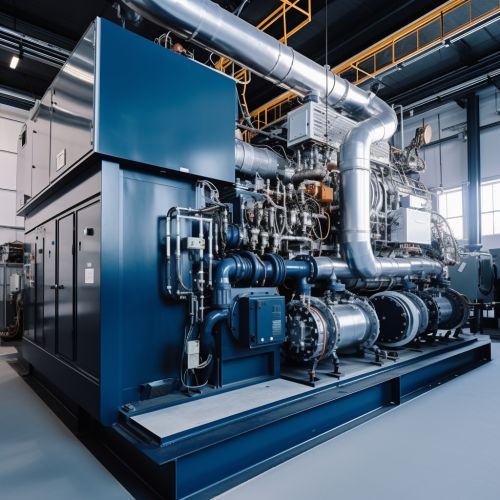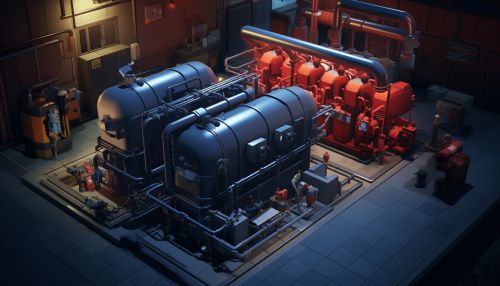Combined Heat and Power (CHP)
Introduction
Combined Heat and Power (CHP), also known as cogeneration, is an efficient system that simultaneously generates electricity and useful heat from the same energy source. This process is considered to be one of the most effective ways to utilize energy, as it can achieve an efficiency rate of up to 90%, compared to the separate production of electricity and heat, which can only reach a maximum efficiency of around 50%.


Principle of Operation
The principle of operation of a CHP system is based on the thermodynamic law of conservation of energy. The system uses a heat engine or power station to generate electricity, and the waste heat that is produced during this process is captured and used for heating purposes, such as space heating, water heating, and industrial processes.
Types of CHP Systems
There are several types of CHP systems, each with their own unique characteristics and applications.
Engine-based Systems
Engine-based systems are the most common type of CHP system. They use an internal combustion engine, which is typically fueled by natural gas, to generate electricity. The waste heat from the engine is then captured and used for heating purposes.
Turbine-based Systems
Turbine-based systems use a gas turbine to generate electricity. The waste heat from the turbine is captured and used for heating purposes. These systems are typically used in larger applications, such as industrial processes and district heating.
Fuel Cell Systems
Fuel cell systems use a chemical reaction to generate electricity, with the waste heat being captured and used for heating purposes. These systems are still in the early stages of development, but they have the potential to be highly efficient and environmentally friendly.
Micro-CHP Systems
Micro-CHP systems are small-scale CHP systems that are designed for residential or small commercial applications. They typically use a Stirling engine or fuel cell to generate electricity, with the waste heat being captured and used for space and water heating.
Benefits of CHP
There are several benefits associated with the use of CHP systems.
Energy Efficiency
The primary benefit of CHP systems is their high energy efficiency. By simultaneously generating electricity and useful heat from the same energy source, these systems can achieve an efficiency rate of up to 90%.
Environmental Benefits
CHP systems also have significant environmental benefits. By utilizing energy more efficiently, these systems can reduce the amount of fossil fuels that are burned, which in turn reduces the amount of greenhouse gases that are emitted into the atmosphere.
Economic Benefits
From an economic perspective, CHP systems can provide significant cost savings. By generating electricity on-site, these systems can reduce the amount of electricity that needs to be purchased from the grid. Additionally, the heat that is generated can be used to offset the cost of purchasing heat from other sources.
Applications of CHP
CHP systems can be used in a wide range of applications, including residential, commercial, and industrial settings.
Residential Applications
In residential settings, CHP systems can be used to provide electricity and heat for homes. These systems can be particularly beneficial in areas where electricity prices are high or where there is a high demand for heat.
Commercial Applications
In commercial settings, CHP systems can be used to provide electricity and heat for buildings, such as offices, hotels, and hospitals. These systems can be particularly beneficial in buildings that have a high demand for both electricity and heat.
Industrial Applications
In industrial settings, CHP systems can be used to provide electricity and heat for industrial processes. These systems can be particularly beneficial in industries that have a high demand for both electricity and heat, such as the chemical, paper, and food processing industries.
Future of CHP
The future of CHP looks promising, with advances in technology and increasing awareness of the benefits of energy efficiency likely to drive further adoption of these systems. In particular, the development of more efficient and environmentally friendly technologies, such as fuel cells, could significantly increase the potential applications of CHP.
